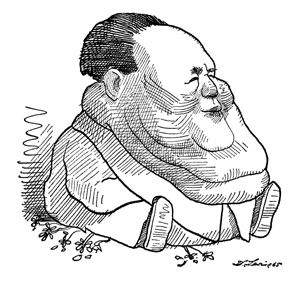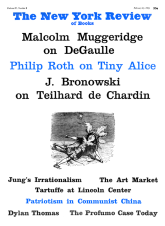Fundamentally China is a sellers’ market. The first half of this century, when there was a glut of books, seems to have been the exception. Since 1949 a veil has once more been drawn over the center of the mysterious east, and the situation has reverted to that of the eighteenth and nineteenth centuries, when any work on China however shallow or careless was seized upon eagerly by the reading public. At first sight Professor Barnett’s work, an apparently hurried compilation of articles written between 1949 and 1955, might appear to exemplify this: the articles are repetitive and disconnected, and the book as a whole has no apparent pattern or direction. In fact, however, the writer is no dilettante and this work is one of the most interesting studies yet to appear on modern China.
Communist China is made up of such a profusion of paradoxes that it is impossible to describe it with both coherence and accuracy. Are the people happy under the new regime? Are they better off? Is the government popular? Is it oppressive? The answer to all of these questions is yes and no. In such a situation the book’s lack of structure is an advantage. With its piecemeal approach it begins to give one the feel of contemporary China in a way that would be impossible in a more methodical study. However, Barnett has not completed even an impressionistic picture of China during the first six years of the new regime, chiefly because he has not described the widespread popular enthusiasm for the Communist government. While it is true that writers sympathetic to the regime have vastly overestimated the extent, depth, and duration of this enthusiasm, it undoubtedly existed, and without some account of it a history of Communist China is completely incomprehensible. Part of the blame for this omission lies with Barnett himself, but most of it is inevitable in this genre.
Anyone but an American must immediately suspect the writings of an American sitting in Hong Kong, interviewing refugees and poring over official Chinese documents, with the apparent purpose of finding admissions of governmental failures. In the case of Barnett these misgivings are rather unfair. Although he is only on the outside rim of China and his sources of information are restricted, his experience of the country and his instinct for the essential enable him to overcome many of the limitations of his position. Indeed he creates a much more convincing picture of China than many people who were there at the time have done. Of course the situation of the expert in Hong Kong is not entirely disadvantageous. In some ways distance from the scene of action improves perspective; a writer’s eyes are often his least reliable source of information.
Barnett’s caution keeps him within the bounds of his information. One positive result of this is that he makes few mistakes, at least in the articles reprinted in this collection; they date very well indeed. At a time when Communism was generally thought to be monolithic, Barnett repeatedly stressed the paucity of Russian aid to China. When many experts considered that “brain washing” was irresistible, Barnett pointed out that it was possible for a completely insincere confession to be singled out for praise by the Chinese authorities.
But this caution is a disadvantage in that by sticking close to his sources Barnett is restricted to a one-sided view of China. He makes very intelligent use of official Chinese publications to describe the structure of the Government, the Communist party, and economic development. But the only flesh he can put on these dry bones comes from refugees. Almost inevitably the refugees from whom he was able to draw the most were those he could get closest to, mentally as well as geographically, namely the Western-educated elite and business men. These people provided a mass of invaluable material on the enforcement of intellectual uniformity and the crushing of the bourgeoisie as a class, but they were not able to give Barnett firsthand information about the devotion and self-sacrifice of hundreds and thousands of party members and cadres, the enthusiasm of millions of poor peasants to whom the regime had given land and some sort of security, and the optimism of people in the towns as inflation was checked and unemployment began to be eradicated. Barnett’s scholarship and caution seem to have been important factors in preventing him from describing such phenomena, about which he had no “hard” information. But the fact that he was writing for an American audience may also have hampered his account of the popularity of the Communist regime. It would have been impossible as well as impolitic for him to convince his readers that Communists could be admired, respected, or loved.
At no stage in its history has the Chinese Communist party had a more positive popular appeal than during the first six years of its rule—the period this book covers. There is of course no doubt about the significance of 1949. 1955, the year in which the study ends, was an almost equally critical year in Chinese history. During that year there was a drastic acceleration in the collectivization of land, which seems to have qualitatively changed the relationship between the regime and the majority of the peasants. In the late Forties and the first two or three years after the establishment of the new Government, Communist party members and cadres urged or compelled the peasants to expropriate the landlords and to punish them, often by death. Their land was then distributed among the poorer peasants. Therefore in China, unlike Russia, the Communist party could claim credit for having distributed the land. During the following four or five years the regime, while declaring its ultimate aim of collectivism, was extremely slow and cautious in its application. During these years there seems, among the peasants, to have been a very widespread feeling of identification with the regime which had fought the Japanese, driven out the corrupt and brutal Kuomintang, and had given them land and the beginnings of economic security. Many peasants at this time appear to have believed that the new government was “their government” in a real sense, and that the Communist party truly represented them. The rapid collectivization in the eight months following May 1955 seems to have broken this almost mystic link. By taking away the ownership of land, the government reverted in many respects to its traditional position in the eyes of the peasants, that of an incomprehensible power to which the small man must bend. Even after that date, however, the regime continued to hold one vital popular asset, its identification with the Chinese nation. There is no doubt about the nationalism of city workers, students, and school children in contemporary China, but it is difficult to assess how widely modern nationalism has diffused among Chinese peasants. Many experts say that it has spread very widely indeed, especially in Eastern China, where the differences between nationalities were brought home by the Japanese occupation. Whatever the real situation, the peasants, whether or not they have been reached by the new nationalism, are moved by the xenophobia that has existed in China for the last hundred years.
Advertisement
The failure to discuss nationalism or xenophobia is the other great short-coming of Barnett’s book. Presumably he considered China’s foreign relations beyond the scope of this work. But without discussing these or the nationalism associated with them it is impossible to understand fully the internal political, social, and economic developments in this period. For instance, America’s direct interference in the Chinese civil war in June 1950, and, in November of that year, China’s intervention in Korea, where she had previously been uninvolved, enabled the regime to demand and receive economic and personal sacrifices for China which it would have been difficult to obtain in the name of Socialism. The Chinese ability to check the American army in Korea had a great influence on such “purely domestic” issues as “thought reform.” After 1952 the Chinese government was able to claim convincingly that it had won China’s first victory over the Western powers, who for a hundred years had so humiliated her. This triumph has placed all those with serious doubts about the regime in an almost impossible position. The Chinese Communist party states repeatedly that all those who are not for it are against it. Thus to doubt is to oppose, and in opposing the party they are opposing the first government to have made China stand up in the modern world. Hence they are opposing China herself. An important element in the success of “thought reform” and “ideological remoulding” is the pressure on the individual brought to bear by the conviction that his doubts make him an enemy of China and the Chinese people. Even now, when the government has failed to produce a major improvement in the standard of living, and has obliterated any trace of freedom, it remains the Chinese Government, the symbol of the power of the Chinese people. Thus when China first exploded an atomic bomb, Chinese from Ssechwan to San Francisco must have felt a surge of pride.
At the end of his book Barnett writes:
In sum while China today is vastly different from what it was in 1949, it is still only a nation ruled by Communists. It has not yet become a Communist nation.
Of course China has not yet reached economic Communism in the Marxist sense; probably she never will. But that does not mean that one cannot usefully call China a Communist nation as opposed to a nation ruled by Communists. Hungary and Czechoslovakia are nations ruled by Communists and the patriotic Hungarian or Czech is anti-Communist. The patriotic Chinese is Communist or he suffers mental agony.
Advertisement
This Issue
February 25, 1965




